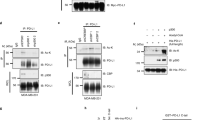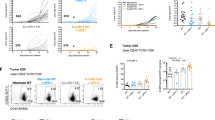Abstract
Innate immune cells such as natural killer (NK) cells play a crucial role in antitumor immune responses. NKG2D is a major activating immunoreceptor expressed in not only NK cells but also CD8+ T cells and shows cytotoxicity against tumors by recognizing its ligands major histocompatibility complex class I-related chain A and B (MICA and MICB) on tumor cells. Recently, it has been suggested that NKG2D-mediated cytotoxicity correlates with the expression levels of NKG2D ligands on target cells. In this study, we were able to increase the expression levels of MICA and MICB on leukemic cell lines and patients' leukemic cells by treatment with trichostatin A (TsA), a histone deacetylase (HDAC) inhibitor. Chromatin immunoprecipitation (ChIP) assays revealed that treatment with TsA resulted in increased acetylation of histone H3 and decreased association with HDAC1 at the promoters of MICA and MICB. Intriguingly, upregulation of MICA and MICB by treatment with TsA led to enhancement of the susceptibility of leukemic cells to the cytotoxicity of NKG2D-expressing cells. Our results suggest that regulation of the expression of NKG2D ligands by treatment with chromatin-remodeling drugs may be an attractive strategy for immunotherapy.
This is a preview of subscription content, access via your institution
Access options
Subscribe to this journal
Receive 12 print issues and online access
$259.00 per year
only $21.58 per issue
Buy this article
- Purchase on Springer Link
- Instant access to full article PDF
Prices may be subject to local taxes which are calculated during checkout



Similar content being viewed by others
References
Cerwenka A, Lanier LL . NKG2D ligands: unconventional MHC class I-like molecules exploited by viruses and cancer. Tissue Antigens 2003; 61: 335–343.
Trinchieri G . Biology of natural killer cells. Adv Immunol 1989; 47: 187–376.
Groh V, Rhinehart R, Randolph-Habecker J, Topp MS, Riddell SR, Spies T . Costimulation of CD8alphabeta T cells by NKG2D via engagement by MIC induced on virus-infected cells. Nat Immunol 2001; 2: 255–260.
Pende D, Cantoni C, Rivera P, Vitale M, Castriconi R, Marcenaro S et al. Role of NKG2D in tumor cell lysis mediated by human NK cells: cooperation with natural cytotoxicity receptors and capability of recognizing tumors of nonepithelial origin. Eur J Immunol 2001; 31: 1076–1086.
Bahram S . MIC genes: from genetics to biology. Adv Immunol 2000; 76: 1–60.
Cosman D, Mullberg J, Sutherland CL, Chin W, Armitage R, Fanslow W et al. ULBPs, novel MHC class I-related molecules, bind to CMV glycoprotein UL16 and stimulate NK cytotoxicity through the NKG2D receptor. Immunity 2001; 14: 123–133.
Pende D, Rivera P, Marcenaro S, Chang CC, Biassoni R, Conte R et al. Major histocompatibility complex class I-related chain A and UL16-binding protein expression on tumor cell lines of different histotypes: analysis of tumor susceptibility to NKG2D-dependent natural killer cell cytotoxicity. Cancer Res 2002; 62: 6178–6186.
Bauer S, Groh V, Wu J, Steinle A, Phillips JH, Lanier LL et al. Activation of NK cells and T cells by NKG2D, a receptor for stress-inducible MICA. Science 1999; 285: 727–729.
Groh V, Rhinehart R, Secrist H, Bauer S, Grabstein KH, Spies T . Broad tumor-associated expression and recognition by tumor-derived gamma delta T cells of MICA and MICB. Proc Natl Acad Sci USA 1999; 96: 6879–6884.
Watson NF, Spendlove I, Madjd Z, McGilvray R, Green AR, Ellis IO et al. Expression of the stress-related MHC class I chain-related protein MICA is an indicator of good prognosis in colorectal cancer patients. Int J Cancer 2006; 118: 1445–1452.
Armeanu S, Bitzer M, Lauer UM, Venturelli S, Pathil A, Krusch M et al. Natural killer cell-mediated lysis of hepatoma cells via specific induction of NKG2D ligands by the histone deacetylase inhibitor sodium valproate. Cancer Res 2005; 65: 6321–6329.
Conejo-Garcia JR, Benencia F, Courreges MC, Gimotty PA, Khang E, Buckanovich RJ et al. Ovarian carcinoma expresses the NKG2D ligand Letal and promotes the survival and expansion of CD28− antitumor T cells. Cancer Res 2004; 64: 2175–2182.
Salih HR, Antropius H, Gieseke F, Lutz SZ, Kanz L, Rammensee HG et al. Functional expression and release of ligands for the activating immunoreceptor NKG2D in leukemia. Blood 2003; 102: 1389–1396.
Verheyden S, Bernier M, Demanet C . Identification of natural killer cell receptor phenotypes associated with leukemia. Leukemia 2004; 18: 2002–2007.
Carbone E, Neri P, Mesuraca M, Fulciniti MT, Otsuki T, Pende D et al. HLA class I, NKG2D, and natural cytotoxicity receptors regulate multiple myeloma cell recognition by natural killer cells. Blood 2005; 105: 251–258.
Poggi A, Venturino C, Catellani S, Clavio M, Miglino M, Gobbi M et al. Vdelta1 T lymphocytes from B-CLL patients recognize ULBP3 expressed on leukemic B cells and up-regulated by trans-retinoic acid. Cancer Res 2004; 64: 9172–9179.
Raulet DH . Roles of the NKG2D immunoreceptor and its ligands. Nat Rev Immunol 2003; 3: 781–790.
Zhang C, Zhang J, Wei H, Tian Z . Imbalance of NKG2D and its inhibitory counterparts: how does tumor escape from innate immunity? Int Immunopharmacol 2005; 5: 1099–1111.
Bubenik J . MHC class I down-regulation: tumour escape from immune surveillance? (review). Int J Oncol 2004; 25: 487–491.
Attwood JT, Yung RL, Richardson BC . DNA methylation and the regulation of gene transcription. Cell Mol Life Sci 2002; 59: 241–257.
Fang JY, Lu YY . Effects of histone acetylation and DNA methylation on p21 (WAF1) regulation. World J Gastroenterol 2002; 8: 400–405.
Kamitani H, Taniura S, Watanabe K, Sakamoto M, Watanabe T, Eling T . Histone acetylation may suppress human glioma cell proliferation when p21 WAF/Cip1 and gelsolin are induced. Neuro-oncol 2002; 4: 95–101.
Woodcock DM, Linsenmeyer ME, Doherty JP, Warren WD . DNA methylation in the promoter region of the p16 (CDKN2/MTS-1/INK4A) gene in human breast tumours. Br J Cancer 1999; 79: 251–256.
Rouhi A, Gagnier L, Takei F, Mager DL . Evidence for epigenetic maintenance of Ly49A monoallelic gene expression. J Immunol 2006; 176: 2991–2999.
Chan HW, Miller JS, Moore MB, Lutz CT . Epigenetic control of highly homologous killer Ig-like receptor gene alleles. J Immunol 2005; 175: 5966–5974.
Vrana JA, Decker RH, Johnson CR, Wang Z, Jarvis WD, Richon VM et al. Induction of apoptosis in U937 human leukemia cells by suberoylanilide hydroxamic acid (SAHA) proceeds through pathways that are regulated by Bcl-2/Bcl-XL, c-Jun, and p21CIP1, but independent of p53. Oncogene 1999; 18: 7016–7025.
Byrd JC, Marcucci G, Parthun MR, Xiao JJ, Klisovic RB, Moran M et al. A phase 1 and pharmacodynamic study of depsipeptide (FK228) in chronic lymphocytic leukemia and acute myeloid leukemia. Blood 2005; 105: 959–967.
Sutheesophon K, Kobayashi Y, Takatoku MA, Ozawa K, Kano Y, Ishii H et al. Histone deacetylase inhibitor depsipeptide (FK228) induces apoptosis in leukemic cells by facilitating mitochondrial translocation of Bax, which is enhanced by the proteasome inhibitor bortezomib. Acta Haematol 2006; 115: 78–90.
Tanaka J, Toubai T, Tsutsumi Y, Miura Y, Kato N, Umehara S et al. Cytolytic activity and regulatory functions of inhibitory NK cell receptor-expressing T cells expanded from granulocyte colony-stimulating factor-mobilized peripheral blood mononuclear cells. Blood 2004; 104: 768–774.
Tanaka J, Iwao N, Toubai T, Tsutsumi Y, Miura Y, Kato N et al. Cytolytic activity against primary leukemic cells by inhibitory NK cell receptor (CD94/NKG2A)-expressing T cells expanded from various sources of blood mononuclear cells. Leukemia 2005; 19: 486–489.
Ghoshal K, Datta J, Majumder S, Bai S, Dong X, Parthun M et al. Inhibitors of histone deacetylase and DNA methyltransferase synergistically activate the methylated metallothionein I promoter by activating the transcription factor MTF-1 and forming an open chromatin structure. Mol Cell Biol 2002; 22: 8302–8319.
Ashburner BP, Westerheide SD, Baldwin Jr AS . The p65 (RelA) subunit of NF-kappaB interacts with the histone deacetylase (HDAC) corepressors HDAC1 and HDAC2 to negatively regulate gene expression. Mol Cell Biol 2001; 21: 7065–7077.
Monneret C . Histone deacetylase inhibitors. Eur J Med Chem 2005; 40: 1–13.
Burgess A, Ruefli A, Beamish H, Warrener R, Saunders N, Johnstone R et al. Histone deacetylase inhibitors specifically kill nonproliferating tumour cells. Oncogene 2004; 23: 6693–6701.
Jinushi M, Takehara T, Tatsumi T, Hiramatsu N, Sakamori R, Yamaguchi S et al. Impairment of natural killer cell and dendritic cell functions by the soluble form of MHC class I-related chain A in advanced human hepatocellular carcinomas. J Hepatol 2005; 43: 1013–1020.
Raffaghello L, Prigione I, Airoldi I, Camoriano M, Levreri I, Gambini C et al. Downregulation and/or release of NKG2D ligands as immune evasion strategy of human neuroblastoma. Neoplasia 2004; 6: 558–568.
Salih HR, Rammensee HG, Steinle A . Cutting edge: down-regulation of MICA on human tumors by proteolytic shedding. J Immunol 2002; 169: 4098–4102.
Holdenrieder S, Stieber P, Peterfi A, Nagel D, Steinle A, Salih HR . Soluble MICA in malignant diseases. Int J Cancer 2006; 118: 684–687.
Acknowledgements
We thank M Yamane, M Mayanagi and Y Ishimaru for their technical assistance. This work was supported in part by a Grant-in-Aid for Scientific Research from the Ministry of Education, Science and Culture, Japan (Tokyo, Japan).
Author information
Authors and Affiliations
Corresponding author
Rights and permissions
About this article
Cite this article
Kato, N., Tanaka, J., Sugita, J. et al. Regulation of the expression of MHC class I-related chain A, B (MICA, MICB) via chromatin remodeling and its impact on the susceptibility of leukemic cells to the cytotoxicity of NKG2D-expressing cells. Leukemia 21, 2103–2108 (2007). https://doi.org/10.1038/sj.leu.2404862
Received:
Revised:
Accepted:
Published:
Issue Date:
DOI: https://doi.org/10.1038/sj.leu.2404862
Keywords
This article is cited by
-
Nitroglycerin: a comprehensive review in cancer therapy
Cell Death & Disease (2023)
-
Small-molecule HDAC and Akt inhibitors suppress tumor growth and enhance immunotherapy in multiple myeloma
Journal of Experimental & Clinical Cancer Research (2021)
-
Metformin inhibits cervical cancer cell proliferation by modulating PI3K/Akt-induced major histocompatibility complex class I-related chain A gene expression
Journal of Experimental & Clinical Cancer Research (2020)
-
BCL11B regulates MICA/B-mediated immune response by acting as a competitive endogenous RNA
Oncogene (2020)
-
Methylation of NKG2D ligands contributes to immune system evasion in acute myeloid leukemia
Genes & Immunity (2015)



